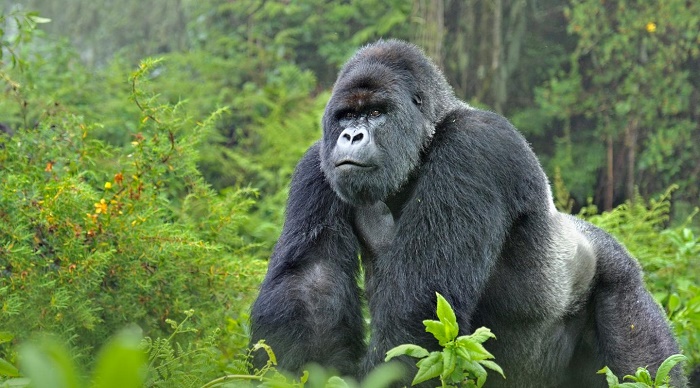Gorillas are gentle giants and display many human-like behaviours and emotions, such as laughter and sadness. In fact, gorillas share 98.3% of their genetic code with humans, making them our closest cousins after chimpanzees and bonobos. The largest of the great apes, gorillas are stocky animals with broad chests and shoulders, large, human-like hands, and small eyes set into hairless faces. The two gorilla species live in equatorial Africa, separated by about 560 miles of Congo Basin Forest. Each has a lowland and upland subspecies.
Nigeria has the Cross River gorilla, which lives in the mountainous border area of Nigeria and Cameroon. It is Africa’s most threatened ape, with a population estimated at fewer than 300 individuals. Around 100 live in Nigeria and are found only in three protected areas in Cross River state: Afi Mountain Wildlife Sanctuary, Mbe Mountains, and the Okwangwo division of Cross River National Park.
Bushmeat hunting, logging, expansion of settlements, and agricultural encroachment continue to jeopardise the survival of the critically endangered Cross River gorilla. Although the gorillas might not be directly targeted by hunters – the great apes mostly inhabit the rugged mountains that are not easily accessible – the wide use of wire snares to capture smaller mammals like rock hyrax and porcupine poses a significant danger to their survival.
The WWF in this listicle lists 10 reasons we need to save or protect gorillas, the issues they are facing, and what you can do to help.

Around 1,063 exist in the wild
There are two gorilla species in the world: the eastern gorilla and the western gorilla. The mountain gorilla is a subspecies of the eastern gorilla.
Mountain gorillas are endangered – there are an estimated 1,063 in the wild according to the latest census results (which come out every 5-10 years).
They live in two isolated groups
Mountain gorillas live in east-central Africa in just two isolated groups – one in the Virunga Volcanoes (a region spanning three national parks in Uganda, Rwanda and Democratic Republic of Congo (DRC)) and one in Bwindi Impenetrable National Park, Uganda, which connects to Sarambwe Nature Reserve, DRC.
They’re found in high altitude montane and bamboo forests, which are surrounded by agriculture and settlements.
We share around 98% of our DNA with gorillas
This means that exposure to human illnesses – even a cold – can have potentially detrimental impacts on gorillas as they are so genetically similar to us, but they haven’t developed the necessary immunities.
They’re one of the biggest, most powerful living primates
An average silverback gorilla can weigh up to 180kg (that’s almost 30 stone), and measure 170cm (over 5’5”) tall on all fours. In contrast, female mountain gorillas weigh 90kg, and measure up to 150cm (4’9”).
They can eat all day long
Mountain gorillas spend about a quarter of their day eating, mainly plants. Around 85% of their diet is made up of leaves, shoots and stems, but gorillas can also eat larvae, snails, ants, and even roots, barks and rotting wood (a good source of sodium/salt).
They cozy up at night
At night, mountain gorilla groups sleep together in nests on the ground, or in trees, that they make from foliage. Infants will share their mother’s nests, staying safe and warm.
They have 16 different types of call
This includes short barks when they’re mildly alarmed or curious.
To intimidate rivals, male gorillas strut with stiff legs, beat their chests, and use vocalisations like roars or hoots.
They live in family groups
Most mountain gorillas live in stable family groups of around 10 individuals, with one dominant male and several females. Both males and females in the group care for their infants; hugging, carrying and playing with them.
When they get older, most males and around 60% of females then leave their birth group to join another troop. This helps prevent inbreeding.
In the wild, gorillas can live to over 40 years old
Gorillas are classed as infants until they reach around three-and-a-half years old, and adults from around eight years.
Males between 8-12 years are called “blackbacks”. Then from 12 years old, they develop a silver section of hair over their back and hips, earning them the name “silverback”.
They’re under threat
The main threat to mountain gorillas is the degradation of their habitat. As the region’s population grows, the land is increasingly converted for agriculture and competition for limited natural resources leads to deforestation. With little other choice, people enter mountain gorilla forests to collect water and firewood, putting gorillas at risk from human contact and illnesses. People may also lay snares intended for bushmeat, which can accidentally injure the great apes.
Gorillas don’t just stay in their forests. They venture onto farmland to eat crops like maize and bananas, which can cause conflict with people who need to make a living.
Gorilla tourism that isn’t well managed is another potential issue, as it can impact the behaviour and health of mountain gorillas.

